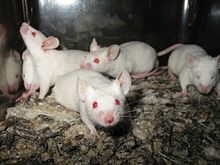BALB/c


BALB/c is an
History
| Animal testing |
|---|
 |
| Main articles |
| Testing on |
|
| Issues |
|
| Cases |
| Companies |
| Groups/campaigns |
|
| Writers/activists |
| Categories |
The founding animals of the strain were obtained by Halsey J. Bagg of Memorial Hospital, New York, from a mouse dealer in
Snell provided some animals from this stock to the National Institutes of Health (NIH) to maintain. In 1961 D. W. Bailey used some of these to generate a substrain at the University of California, San Francisco. In 1974, now 136 generations from the original breeding pair, these animals were returned to The Jackson Laboratory and were named BALB/cByJ.[3] On 16 November 2005, The Jackson Laboratory reported this substrain had reached its 235th generation.[4]
Snell also provided a colleague, J. Paul Scott, with some BALB/c breeding stock in 1938 or 1939.[2] When a fire destroyed the main Jackson Laboratory buildings in 1947,[5] all of Snell's original breeding stock perished, but Scott's mice were in a different building and survived. Scott donated stock back, at generation 41, to repopulate the colony. The progeny of these are now termed BALB/cJ and, as of 14 December 2006, were 221 generations from the founding stock.[6] Other less popular substrains, such as BALB/cWt, are maintained at the Jackson Laboratory, while the BALB/cN substrain is maintained by the NIH.[3]
Characteristics

BALB/c mice are useful for research into both cancer and immunology. According to
There are noted differences between different BALB/c substrains, though these are thought to be due to
The BALB/cJ[10] mice have a medium lifespan of about 17 months for males and 20 months for females,[11] and the body weight at 9 weeks after birth is about 27 g (0.95 oz) for males and 21 g (0.74 oz) for females.[12]
See also
- Animal model
- Animal testing on rodents
- C57BL/6
References
- ^ a b c d "BALB/c". Inbred Strains of Mice. Jackson Laboratory. Retrieved 16 April 2007.
- ^ a b Potter M. History of the BALB/c family, pp. 1–5. In: The BALB/c Mouse: Genetics and Immunology, Current Topics in Microbiology and Immunology, Vol. 122. Springer-Verlag, NY. 1985.
- ^ a b c "A Brief History of the Two Substrains of BALB/c, BALB/cJ, and BALB/cByJ". Jax Mice Literature. Jackson Laboratory. Archived from the original on 19 June 2011. Retrieved 30 September 2010.
- ^ a b c "BALB/cByJ". Jax Mice Data Sheet. Jackson Laboratory. Archived from the original on 16 November 2006. Retrieved 16 April 2007.
- ^ "The Jackson Laboratory Milestones: 1940 – 1949". The Jackson Laboratory Timeline. Jackson Laboratory. Archived from the original on 15 September 2007. Retrieved 16 April 2007.
- ^ a b c "BALB/cJ". Jax Mice Data Sheet. Jackson Laboratory. Archived from the original on 11 April 2007. Retrieved 16 April 2007.
- ^ Hilgers J., van Nie R., Ivanyi D., Hilkens J., Michalides R., de Moes J., Poort-Keesom R., Kroezen V., von Deimling O., Kominami R., and Holmes R. (1985) Genetic differences in BALB/c sublines. Curr. Top. Microbiol. Immunol. 122, 19-30.
- ^ Southwick C. H. and Clark L. H. (1966) Aggressive behaviour and exploratory activity in fourteen mouse strains. Am. Zool. 6, 559.
- PMID 7470243
- ^ "BALB/cJ". jax.org. Retrieved 18 September 2022.
- ^ "BALB/c Bagg's Albino" (PDF). insights.envigo.com. Retrieved 18 September 2022.
- ^ "Physiological Data Summary – BALB/cJ" (PDF). jackson.jax.org. Retrieved 18 September 2022.
